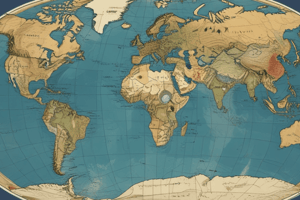Podcast
Questions and Answers
What is the term for the energy released during an earthquake?
What is the term for the energy released during an earthquake?
- Boltss
- Moment magnitude
- Modified mescaline
- Richter (correct)
What is the process of wearing away of soil and rock by natural forces like water and wind?
What is the process of wearing away of soil and rock by natural forces like water and wind?
- Erosion (correct)
- Sea fetch
- Longshore drift
- Deposition
What type of waves are responsible for building up our beaches?
What type of waves are responsible for building up our beaches?
- Constructive waves (correct)
- Destructive waves
- Sea swash
- Longshore drift
What is the term for the distance in which the wind blows over the sea?
What is the term for the distance in which the wind blows over the sea?
What is the term for the formation of sediment by longshore drift?
What is the term for the formation of sediment by longshore drift?
What is the term for the remnants of sea cliffs eroded by wave action?
What is the term for the remnants of sea cliffs eroded by wave action?
What is the term for the water that rushes up the beach?
What is the term for the water that rushes up the beach?
What is the term for the features that connect islands or offshore rocks to the mainland?
What is the term for the features that connect islands or offshore rocks to the mainland?
What is the primary driver of the circular motion of magma in the mantle?
What is the primary driver of the circular motion of magma in the mantle?
What type of plate boundary is characterized by one plate subducting beneath another?
What type of plate boundary is characterized by one plate subducting beneath another?
What is the name of the theory that proposes that continents were once joined as a single supercontinent?
What is the name of the theory that proposes that continents were once joined as a single supercontinent?
Where does new oceanic crust form through volcanic activity?
Where does new oceanic crust form through volcanic activity?
What type of mountains are formed by the folding of rock layers due to tectonic compression?
What type of mountains are formed by the folding of rock layers due to tectonic compression?
What is the scale used to measure the magnitude of earthquakes?
What is the scale used to measure the magnitude of earthquakes?
What is the primary cause of tsunamis?
What is the primary cause of tsunamis?
What type of wave can travel through only solids?
What type of wave can travel through only solids?
Flashcards are hidden until you start studying
Study Notes
Measuring Earthquakes
- Richter scale measures the energy released during an earthquake
- Moment magnitude measures the movement of faults during an earthquake
Graphing Data
- BOLTS: a mnemonic for the essential components of a graph, including Border, Orientation, Legend, Title, Scale, and Source
Coastal Processes
- Longshore drift: the transportation of sediments along a coast parallel to the shoreline
- Factors influencing wave formation:
- Fetch: the distance in which the wind blows
- Swash: the water that rushes up the beach
- Backswash: the water that flows back towards the sea
- Types of waves:
- Constructive waves: have little energy, responsible for building up beaches
- Destructive waves: have stronger backwashes than swashes, contributing to coastal erosion
Erosion and Deposition
- Erosion: the wearing away of soil and rock by natural forces like water and wind
- Types of coastal features formed by erosion:
- Caves: created by the dissolution of soluble rocks like limestone by acidic water
- Arches: formed by the erosion of softer rock beneath harder layers
- Stacks and Stumps: remnants of sea cliffs eroded by wave action
- Spits: formed by the deposition of sediment by longshore drift, extending from the shoreline into open water
- Deposition: the process of sediments or rock particles being deposited onto a surface by natural forces
- Types of coastal features formed by deposition:
- Beaches: recreational areas, wildlife habitats, and buffers against erosion
- Spits: provide protection to coastlines
- Bars: influence coastal dynamics by affecting wave patterns and sediment transport
- Tombolos: connect islands or offshore rocks to the mainland, providing accessibility and sometimes acting as protective barriers against wave action
- Sand dunes: stabilize coastal ecosystems, protect inland areas from storm surges and erosion, and provide habitats for specialized plant and animal species
Plate Tectonics
- Convection currents: circular motion of magma in the mantle driven by heat from the Earth's core, responsible for the movement of tectonic plates
- Plate boundaries:
- Constructive: plates move apart, forming new crust
- Destructive: one plate subducts beneath another
- Transform: plates slide past each other horizontally
- Continental drift: theory proposing that continents were once joined as Pangaea and drifted to their current positions
- Evidence for continental drift:
- Matching coastlines
- Rock formations
- Fossils
- Paleo climate data
- Sea floor spreading: new oceanic crust forms at mid-ocean ridges through volcanic activity, supporting plate tectonics
- Fold mountains: formed by the folding of rock layers due to tectonic compression
- Earthquakes: sudden shaking of the ground caused by the release of energy from tectonic plates
- Tsunamis: large ocean waves caused by underwater earthquakes, volcanic eruptions, or landslides, devastating coastal areas
- Volcanoes: formed at convergent boundaries, divergent boundaries, or hot spots, with effects including ashfall, pyroclastic flows, and lava flows
- Types of seismic waves:
- P waves: can travel through solids and liquids
- S waves: can travel through only solids
Studying That Suits You
Use AI to generate personalized quizzes and flashcards to suit your learning preferences.




